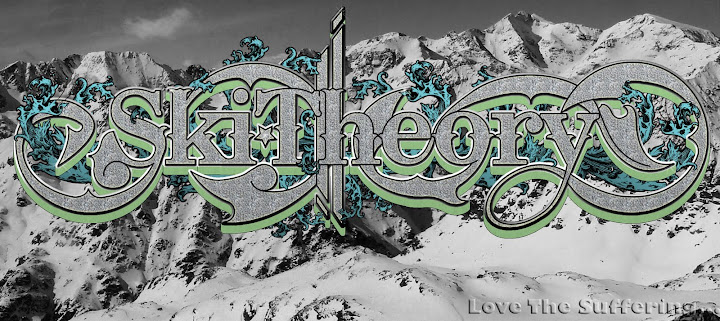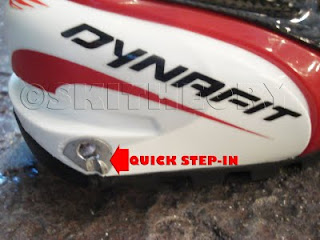The snow is falling, the air is cool, and the end of October or start of November is the time you should begin to prep your training skis, and race skis, for the upcoming season. Starting to get your skis ready now will mean faster skis later. That being said, I like my skis to be fast, but I don't wax and tune them the same way I would a downhill race ski. Going to fast with tiny skis through rough terrain may cause a fall, and thus time lost during the race. My goal is to glide as quickly as possible on the flats, rather than looking for speed in couloirs or descents where I am trying to keep my speed in check, which will allow more time to recover from less skating.
To start you need a stone grind. A stone grind is vital to making sure you have a great all around base structure, that will help clear the water underneath your skis (you ski on water not snow technically), and help guard against any suction on the base. An all around structure is perfect for being on the road, when your unsure of upcoming race conditions. A coarse structure is better suited to wet conditions, whereas in colder conditions you should be able to see the structure but not feel it with your fingers (fine), an all around structure is right in between. If you would like to choose a specific structure for time of season, or known snow/weather conditions do so, just don't be wrong. Grinding the base will also renew the skis base, flatten the ski, and allow the base to accept wax much better. Make sure that you are not getting a
belt grind, as it will not flatten your base properly! We can talk base structure all day, but for Rando racing, it is not as important as downhill racing. When it comes to stone grinding machines, I prefer Montana, opposed to Wintersteiger machines.
After your base grind, the shop will probably put a base bevel on your skis, usually around 0.5 degrees. It's time to sharpen your skis. I recommend a 2 degree side edge bevel. The reason why 2 degrees is the angle of choice, is because it is the best balance between strength and sharpness. Anything more/less will result in more strength but less edge hold or vise versa. Always sharpen before you wax, as to not push any metal shavings into the base, and into your new wax job, polluting your base. De-tuning the tips and tails slightly will help your skis from catching an edge, and will allow you to throw them around with ease, and less chance of them catching.

Now after all this, comes the waxing. Waxing is one thing we all concentrate on, but without a good base grind and structure, you can negate its benefits causing more suction and a sticky base feel. Your first wax should be with a generic softer wax, with no added fluorocarbons. Waxing for the first time with a Fluorocarbon wax will actually damage you base on a microscopic level, and slow you down. Start with Mr Miyagi's wax on wax off. Wax one thin coat of your generic wax onto the ski, and scrape it off before it cools, this will help clean your base and "de-fang" the structure. If you consider yourself really hardcore in your tuning, you can do this around 5 or 6 more times, to make sure your base is really well setup. When scraping, make sure to scrape tip to tail with even pressure, in one direction and pushing the used wax off the ski as to not push it into the base.

After each wax and scrape, you must make sure to brush your skis. I recommend using a medium to stiff horsehair brush. Nylon brushes will electronically charge your base, slowing you down on those dreaded flats, so horsehair is your brush of choice. Brushing helps clean out the structure, that you paid so well to have laid down on your base, and prep the base for yet another coat of wax. Wipe the ski with a fibertex pad under a brush or scraper (distributes the pressure evenly), approx 50 times, to take off any micro hairs left over.
Now here's where things differ from Rando racing to Downhill racing. I recommend using a low to medium Fluorocarbon wax, starting your waxing with a low Fluoro and moving to medium Fluoro, such as Swix F4, after the initial first few waxes. Each time you wax, make sure the iron is just below it's smoking point so you won't destroy the Fluorocarbon content of the wax (which happens when improperly heated), and continue running the iron over the skis (front to back)
for a few minutes. Make sure to let the skis cool for at least 20 minutes. You can also begin using a hotbox for this process if you are lucky enough to have access to one. This will help open up the pores of the ski and accept more wax. If you live in a colder climate (e.g. Rockies vs Coast Range), start with softer warmer waxes then move to harder colder waxes. Cold wax is their to protect your base from burning which will create micro hairs and slow you down, and is why your bases are white and furry after a cold day.
Now that you've put on your dozen coats of wax or so, it's time to ski them. This is important,
ski your skis before putting skins on them! I recommend doing this as there will be a small amount of residue wax and putting your skins on early will pollute the glue on a race set of skins. Your skis are now ready to go, and this is why you may not want to go spend all your paycheck on race wax, as you will ski some of it off. I'll usually ski one top to bottom run on my race skis here in Whistler, then retire them for the first race.
This method has seemed to work really well for me, and benefit my "system" of skins and skis the best. Every time I didn't take a run without skiing my skis first, my skins would come off too easily, and I would be worrying for the rest of the race when the problem would correct itself. With each successive tune throughout the season, the skis will get faster and faster, giving you a better chance to win.





































